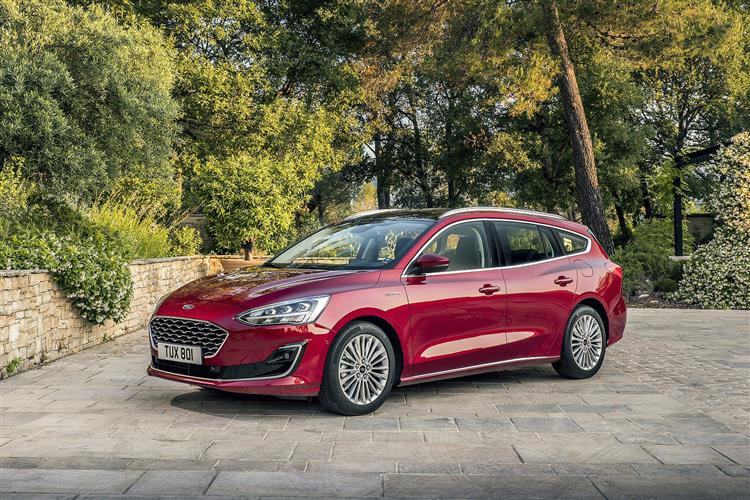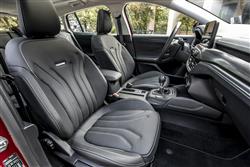How will you view?
This is a sample, showing 30 seconds of each section.
COMPACT ESTATEMENT (some text hidden) SECTIONED_new_fordfocusestate_2019
By Jonathan Crouch
Introductionword count: 79
The fourth generation 'C519'-series Ford Focus Estate launched in 2018 put its maker right back into contention in the compact estate segment, with more boot space, sleeker looks, a more user-friendly interior, more efficient engines and some suspension tweaks that aimed to remind us what made this station wagon Focus great in the first place. It's not the biggest or the cheapest estate in its sector from the 2018-2022 period, but it might just be the most appealing all-rounder.
Modelsword count: 12
[petrol] 1.0, 1.5 & 2.3 EcoBoost / [diesel] 1.5 & 2.0 EcoBlue
Historyword count: 364
Ford's Focus is best known as a family hatch, but if you need a little added practicality, it's this estate version that'll suit you best. Here, we look at the fourth generation version, sold in its earliest forms between 2018 and 2022. Such is the pull of small SUVs that the small estate car seems to have had its last rites read time and again, yet still the compact station wagon struggles on. Models like this are still around because they're a good idea. What's more, if people were honest about why they really needed a vehicle, a family hatch-based estate car would often make more practical sense than an equivalently-sized Crossover. After all, a traditional station wagon can carry just as much as many SUVs, yet will be better to drive, lighter and more aerodynamic which means better efficiency. And a family hatch-based estate will almost certainly be cheaper to buy too. Ford's brought us some brilliant estates down the years but as much as customers have warmed to the Focus hatch, the five-door estate has never occupied a huge slice of the overall Focus sales pie chart. This MK4 version aimed to formulate a more convincing argument. It got an all-new C2 platform that enabled a longer wheelbase that for the first time allowed this car to offer properly class-competitive rear seat room and luggage space - there's up to 728-litres of it. Buyers could also choose an SUV-orientated 'Active' trim level, which made a bit more of a lifestyle statement and offered some useful low traction driving modes. Much changed beneath the bonnet too for this MK4 design, with clever cylinder deactivation for the petrol models and the new 1.5-litre three cylinder petrol unit we first saw in the Fiesta ST. The diesel engines were re-designed too. As was the much higher quality cabin, which featured half the number of previous buttons. On top of all that, the brand claimed class-leading camera-driven safety standards too. This MK4 Focus Estate was updated with a mild hybrid version of the 1.0-litre EcoBoost petrol unit in 2020; then fully facelifted at the end of 2021. It's the pre-facelift 2018-2021-era models we look at here.
What You Getword count: 376
Like its Hatch stablemate, this fourth generation Focus Estate matured in almost every way. It was taller and longer than its predecessor, being nearly 1.5-metres high and stretching to nearly 4.7-metres in length, with a rear overhang almost a foot longer than that of the equivalent hatch model. As with that body shape, the wheels of the MK4 model were further apart and the glass area was larger, all of this part of the brand's 'human-centric' design philosophy. Inside, Ford hoped buyers would find the ambiance of this fourth generation model much more inviting. To that end, the dashboard was pulled forward and there was a slimmer, lower centre console, plus the new body shell freed up more room for shoulders and knees. As a result, you no longer feel quite so hemmed-in at the wheel, but by the same token, there's also slightly less of the cockpit-style positioning that we rather liked before. You can't fault the cleaner, sharper ergonomics though, aided by a massive 50% reduction in button clutter, with as many functions as possible relocated to the cabin's prominent SYNC 3 infotainment screen that, in keeping with current automotive fashion, sprouts from the top of the dash. All of which is interesting - but perhaps not quite so fundamentally significant as the changes which took place further back in this fourth generation model. The space on offer here certainly didn't redefine what the compact estate segment could offer, but at the launch of this MK4 model, it did at least begin to typify it. In a Focus, back seat folk were with this fourth generation design treated much as they would be in a rival Golf Estate, thanks to 56mm more knee clearance, 78mm more legroom and 60mm more shoulder room. The boot offers up to 728-litres of space if you load to the roof. That's quite a big increase on the figure you'd get in a Focus Hatch - up to 443-litres. Fold down the 60:40-split rear bench and you're looking at up to 1,620-litres for the Estate and up to 1,320-litres for the Hatch. Bear in mind that these figures will reduce if you opt a car fitted with for either a full-sized spare wheel or the optional B&O audio system.
To see the full road test text contact us on 0330 0020 227
Pictures (high res disabled)

.jpg)
|
.jpg)
|
.jpg)
| |||
.jpg)
|
.jpg)
|
.jpg)
| |||
.jpg)
|

|
Scoring (subset of scores)
Category: Spacious Family Cars
| Performance | |
| Handling | |
| Comfort | |
| Space | |
| Styling, Build, Value, Equipment, Depreciation, Handling, Insurance and Total scores are available with our full data feed. | |





